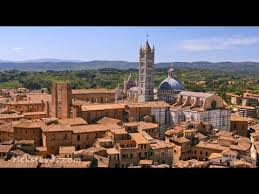Setting off for a short vacation, I popped my copy of the Granada TV rendition of Brideshead Revisited into my bag. I had a personal memory of the series because I was studying in Oxford when it was being filmed. I stood by the Bodleian Library and watched Anthony Andrews and Jeremy Irons stride from the porter’s lodge of Hertford College, climb into their open-topped car and roar off under the Bridge of Sighs headed for Brideshead. Later, I was sure I spotted Laurence Olivier wandering down the Broad.
The Granada television series is probably the most exquisite and faithful screen adaptation of any work of fiction. John Mortimer’s intelligent and sensitive script is faithful to Waugh’s intention despite Mortimer’s own atheism. Charles Sturridge’s subtle direction teamed with the perfect cast not only tells Waugh’s story, but brings to life the aristocratic extravagance of the period. Oxford, as we would all like to imagine it, is in full flower, and when Venice and the sumptuous Castle Howard (standing in for Brideshead) are thrown in, the effect is at once opulent and decadent. The English hauteur played with confidence and nonchalance resonates with a strange innocence and a lingering fin-de-siècle sadness.
So in a cabin in the mountains of North Carolina I settled down to indulge not only in what Waugh called his GEM (Great English Masterpiece), but also in my own nostalgia for happy days in Oxford, and to ponder the unique way God was at work not only in the Flyte family, but in my own limping pilgrimage to the Catholic faith.
A friend once observed that Brideshead could stand for the Catholic Church – the “bride” of Christ who is the “head” of the Church. Is that a flight (excuse the pun) of fancy? I don’t think Evelyn Waugh was writing an allegory, but there are interesting symbols interwoven into the story, which unlock the deeper Catholic significance of the work.
Firstly, the palatial home is certainly greater and more ancient than the ephemeral Flyte family whose story occupies Waugh’s plotline. Sebastian Flyte tells Charles Ryder that Brideshead had been an ancient castle before an ancestor took the stones and re-built what another antique aunty called “the new house.” That it was Catholic then is echoed by Lord Marchmain’s reflection that, in his marriage and conversion, Lady Marchmain had brought the family back to the “religion of his ancestors.”

Prayerful Catholic convert, Charles Ryder (Jeremy Irons), revisits Brideshead
Sturridge’s visual telling of the story unlocks other details that identify Brideshead with the Catholic Church. Nanny Hawkins lives in an attic room, and the television portrayal reveals her little sitting room as a kind of Catholic shrine. Although the story unfolds over a span of twenty years, Nanny Hawkins never moves from her armchair and does not seem to age. Ever kindly, forgiving, and thinking the best, Nanny Hawkins is the mother figure to whom Sebastian and his sisters, Julia and Cordelia, are truly attached. Lodged in the attic of the old house she thus becomes a personification of the larger symbol of Brideshead as Mother Church.
In another visual reference to Mother Church, when Charles visits the burnt-out Sebastian in a hospital in Morocco to inform him of Lady Marchmain’s impending death, Sebastian muses sadly, “Poor Mummy. She always was a femme fatale.” He then turns away and gazes on a cheap icon of the Madonna and Child. It is as if Sebastian has transferred his affections from his earthly mother to Mary Mother of the Church. Therefore, the theme of Brideshead as Mother Church echoes through the story, and if the ancestral home is Mother Church, then the pathetically prodigal Flyte children are orphans.
In the story, they are made orphans first by their irresponsible father who abandons the family for a louche and luxurious life in Venice with his Italian mistress. They are further orphaned by the coldly manipulative and self-righteous Lady Marchmain. Bridey, the heir, takes refuge in a reclusive, hardhearted Pharisaism, while Julia and Sebastian take flight into sexual license, alcoholism, and rejection of their faith. Only the little child, Cordelia, finds true faith in the wilderness of a desolate and dysfunctional family.
Through it all, the sanctuary lamp within the ornate chapel of the grand house burns as a faithful beacon. The permanence of Brideshead stands not only as mother church, but also like the father of the prodigal waiting to welcome the orphans home. Lord Marchmain’s return to the house and to his Catholic faith is a prophetic sign of repentance and return. And when Charles, in the midst of the uncertainties of war, also returns we are left with the realization that each one of the Flyte family, through their own “twitch on the thread,” have been brought home to Mother Church. Each one will return ransomed, healed, restored, and forgiven. And in doing so they will revisit Brideshead, to remain forever.















